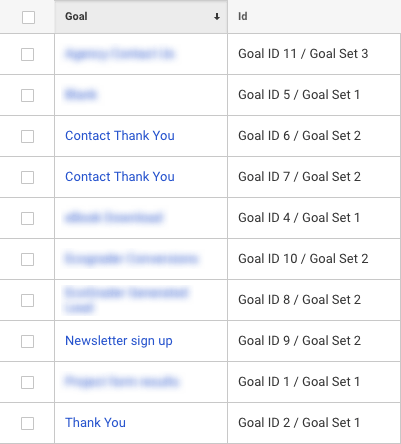What Data Is Google Analytics Goals Unable to Track: Discover the Limitations
What Data Is Google Analytics Goals Unable to Track: Discover the Limitations
Blog Article
Discover the Limitations of Google Analytics Goals: Revealing the Information Types That Remain Untrackable
As businesses increasingly depend on data-driven decision-making, understanding the limitations of tools like Google Analytics ends up being critical. While Google Analytics Goals offer useful understandings right into individual communications, there exist information types that avoid monitoring, posturing challenges to a detailed understanding of individual habits.
Insufficient Individual Journey Tracking
Incomplete customer journey monitoring within Google Analytics can hinder the capability to properly evaluate customer actions. When the customer trip is not completely tracked, there are spaces in the data that prevent a comprehensive understanding of exactly how users engage with an internet site. This lack of insight can bring about missed out on chances for optimization and renovations to the customer experience.
One common concern with insufficient user trip monitoring is the failure to see the full path that users take previously finishing a goal or leaving the website. Without this information, it is challenging to recognize where individuals might be encountering barriers or friction factors that prevent them from converting. Furthermore, incomplete tracking can obscure the effect of certain advertising and marketing initiatives or internet site modifications on individual behavior.
To address this limitation, it is crucial to set up appropriate monitoring devices within Google Analytics to capture the whole user trip. This may include establishing up occasion monitoring, objective funnels, or utilizing devices like Google Tag Manager to make certain that no vital interactions go unrecorded. By getting an extensive view of the customer trip, web site owners can make even more enlightened decisions to improve customer engagement and drive conversions.
Acknowledgment Obstacles
Navigating through attribution obstacles in Google Analytics requires a thorough understanding of how various touchpoints add to the total conversion procedure. Acknowledgment obstacles arise from the intricacy of modern customer trips, where customers connect with numerous channels before transforming.
One usual acknowledgment challenge is the difficulty in associating conversions to the appropriate source, particularly in instances where customers connect with numerous networks before transforming. This can result in mistakes in determining which advertising initiatives are driving one of the most conversions. Furthermore, cross-device tracking presents another acknowledgment challenge, as customers commonly change between tools throughout their trip, making it challenging to track their interactions flawlessly. Marketers have to carefully examine and analyze acknowledgment information to make enlightened choices and enhance their advertising strategies properly.
Offline Conversions
Offered the challenges related to connecting conversions precisely in online channels, the dimension of offline conversions provides a considerable opportunity for marketers seeking a more detailed understanding of their clients' trip. Offline conversions refer to activities that customers absorb the real world, such as making acquisitions in brick-and-mortar shops or over the phone, attending events, or involving with printed materials - what data is google analytics goals unable to track. These conversions are important for organizations this page that run both online and offline, as they give valuable understandings into the effectiveness of advertising projects across numerous touchpoints
Tracking offline conversions typically postured a significant obstacle for marketing experts, as it was challenging to link these actions back to specific online interactions properly. Nonetheless, with developments in modern technology, such as the assimilation of CRM systems, one-of-a-kind identifiers, and promo code codes, businesses can currently connect the void in between online and offline information to acquire a more alternative sight of consumer habits. By successfully measuring offline conversions, marketing professionals can enhance their approaches, allot sources a lot more efficiently, and eventually improve the overall consumer experience.
Cross-Device Tracking
Cross-device tracking plays a crucial duty in comprehending the interconnected nature of customers' electronic communications throughout several tools. In today's omnichannel world, where customers seamlessly change in between desktops, mobile phones, and tablet computers, tracking their behavior across these tools is important for marketers to get a comprehensive sight of their customer journey.

Moreover, privacy worries and laws such as GDPR and CCPA have even more complex cross-device monitoring. With users demanding more control over their information and boosted restrictions on tracking technologies, marketers need to locate privacy-compliant and cutting-edge means to connect individual interactions throughout tools.
Dynamic Web Content Involvement
Recognizing customer engagement with vibrant web content is pivotal in maximizing digital advertising and marketing techniques for improved audience interaction. Dynamic content describes web site components that transform based upon individual behavior, preferences, or other variables, offering a personalized experience. Nonetheless, tracking individual interactions with dynamic web content poses difficulties for standard analytics tools like Google Analytics.
While Google Analytics can track fundamental interactions like clicks and web page views, it might have a hard time to catch even more nuanced engagements within dynamic content. what data is google analytics goals unable to track. Metrics such as time invested in particular vibrant components, float activities, or communications within pop-ups are typically not easily measurable using basic monitoring techniques. This limitation impedes marketing experts' look at here now capacity to fully realize exactly how users are engaging with vibrant content and tailor their techniques as necessary

Verdict
To conclude, Google Analytics goals have constraints in tracking incomplete individual journeys, attributing conversions accurately, capturing offline conversions, tracking cross-device interactions, and measuring dynamic material interaction. These restraints highlight the relevance of checking out added tracking methods and tools to acquire an extra extensive understanding of user habits and conversions past what Google Analytics can offer.
While Google Analytics Goals offer valuable insights into individual communications, there exist information types that avoid monitoring, presenting difficulties to an extensive understanding of customer habits.Incomplete customer trip tracking within Google Analytics can impede the capacity to properly analyze user actions. When the customer journey is not completely tracked, there are spaces in the data that prevent a comprehensive understanding of how individuals communicate with a web site.One typical problem with incomplete individual trip tracking is the lack of ability to see the full path that users take in the past finishing a goal or leaving the site. By gaining an extensive sight of the user trip, internet site proprietors can make more informed decisions to enhance customer involvement and drive conversions.
Report this page